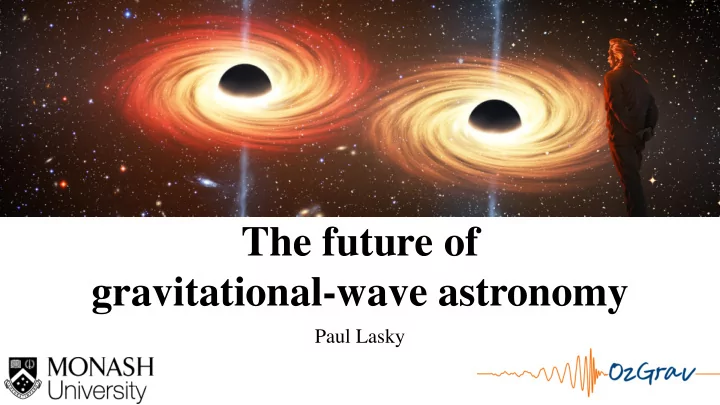

The future of gravitational-wave astronomy Paul Lasky
1,000,000,000 years ago
14th September 2015 - GW150914 Hanford, Washington (H1) Livingston, Louisiana (L1) 1.0 0.5 0.0 -0.5 -1.0 L1 observed Strain (10 -21 ) H1 observed (shifted, inverted) H1 observed Normalized amplitude 1.0 0.5 0.0 -0.5 -1.0 Numerical relativity Numerical relativity Reconstructed (wavelet) Reconstructed (wavelet) Reconstructed (template) Reconstructed (template) 0.5 0.30 0.35 0.40 0.45 0.30 0.35 0.40 0.45 Time (s) Time (s)
Binary Black secondary mass [M ☉ ] 35 600 Hole Merger distance [Mpc] 400 200 25 0 0 90 180 30 40 50 orientation (deg) primary mass [M ☉ ] Sky location unknown Abbott et al. (2016) - GW150914
fast forward — August 17, 2017 GW150914 GW101512 GW151226 GW170104 GW170814 GW170817
August 17, 2017 GRB start Merger 2500 Lightcurve from Fermi /GBM (10 − 50 keV) Event rate (counts/s) 2250 2000 1750 1500 1250 Lightcurve from Fermi /GBM (50 − 300 keV) Event rate (counts/s) 1750 1500 1250 1000 750 Lightcurve from INTEGRAL/SPI-ACS Event rate (counts/s) 120000 ( > 100 keV) 117500 115000 112500 Gravitational-wave time-frequency map 400 Frequency (Hz) 300 So loud you can see it by eye 200 SNR = 32.4 100 (louder than GW150914) 50 − 10 − 8 − 6 − 4 − 2 0 2 4 6 Time from merger (s)
11 hours later Swope - the first of many! credit: Coulter et al. (2017)
inference from gravitational-wave data alone 1.3 mass 2 [M � ] 3000 tidal deformability of secondary 1.0 2000 0.7 1.5 2.0 2.5 1000 mass 1 [M � ] 0 0 1000 2000 3000 tidal deformability of primary Abbott et al. (2017; GW170817)
gravitational-wave transient catalog(ue) - 1 Abbott et al. 2018
<latexit sha1_base64="fRxlI70PEIn1kj4otPjwQ8UVB8c=">AC3icbZBNS8MwGMdTX+d8q3r0EjYED2O0Iuhx6MWLMG9QFtKmqZbWNKUJBVG2d2LX8WLB0W8+gW8+W3Mth508w+BH/neZI8/yhjVGnH+bZWVtfWNzYrW9Xtnd29fvgsKtELjHpYMGE7EdIEUZT0tFUM9LPJE8YqQXja6n9d4DkYqK9F6PMxJwNEhpQjHSxgrtWuFLDjNJOZJjv+E3OFJqMgXvNvRFLHQ2nWn6cwEl8EtoQ5KtUP7y48FzjlJNWbmOs91Mh0USGqKGZlU/VyRDOERGhDPYIo4UEx2UCT4wTw0RIc1INZ+7viQJxpcY8Mp0c6aFarE3N/2perpPLoKBplmuS4vlDSc6gFnAaDIypJFizsQGEJTV/hXiIJMLaxFc1IbiLKy9D96zpOk37rzeuirjqIBjUAOnwAUXoAVuQBt0AaP4Bm8gjfryXqx3q2PeuKVc4cgT+yPn8AaFqaoA=</latexit> <latexit sha1_base64="fRxlI70PEIn1kj4otPjwQ8UVB8c=">AC3icbZBNS8MwGMdTX+d8q3r0EjYED2O0Iuhx6MWLMG9QFtKmqZbWNKUJBVG2d2LX8WLB0W8+gW8+W3Mth508w+BH/neZI8/yhjVGnH+bZWVtfWNzYrW9Xtnd29fvgsKtELjHpYMGE7EdIEUZT0tFUM9LPJE8YqQXja6n9d4DkYqK9F6PMxJwNEhpQjHSxgrtWuFLDjNJOZJjv+E3OFJqMgXvNvRFLHQ2nWn6cwEl8EtoQ5KtUP7y48FzjlJNWbmOs91Mh0USGqKGZlU/VyRDOERGhDPYIo4UEx2UCT4wTw0RIc1INZ+7viQJxpcY8Mp0c6aFarE3N/2perpPLoKBplmuS4vlDSc6gFnAaDIypJFizsQGEJTV/hXiIJMLaxFc1IbiLKy9D96zpOk37rzeuirjqIBjUAOnwAUXoAVuQBt0AaP4Bm8gjfryXqx3q2PeuKVc4cgT+yPn8AaFqaoA=</latexit> <latexit sha1_base64="fRxlI70PEIn1kj4otPjwQ8UVB8c=">AC3icbZBNS8MwGMdTX+d8q3r0EjYED2O0Iuhx6MWLMG9QFtKmqZbWNKUJBVG2d2LX8WLB0W8+gW8+W3Mth508w+BH/neZI8/yhjVGnH+bZWVtfWNzYrW9Xtnd29fvgsKtELjHpYMGE7EdIEUZT0tFUM9LPJE8YqQXja6n9d4DkYqK9F6PMxJwNEhpQjHSxgrtWuFLDjNJOZJjv+E3OFJqMgXvNvRFLHQ2nWn6cwEl8EtoQ5KtUP7y48FzjlJNWbmOs91Mh0USGqKGZlU/VyRDOERGhDPYIo4UEx2UCT4wTw0RIc1INZ+7viQJxpcY8Mp0c6aFarE3N/2perpPLoKBplmuS4vlDSc6gFnAaDIypJFizsQGEJTV/hXiIJMLaxFc1IbiLKy9D96zpOk37rzeuirjqIBjUAOnwAUXoAVuQBt0AaP4Bm8gjfryXqx3q2PeuKVc4cgT+yPn8AaFqaoA=</latexit> <latexit sha1_base64="fRxlI70PEIn1kj4otPjwQ8UVB8c=">AC3icbZBNS8MwGMdTX+d8q3r0EjYED2O0Iuhx6MWLMG9QFtKmqZbWNKUJBVG2d2LX8WLB0W8+gW8+W3Mth508w+BH/neZI8/yhjVGnH+bZWVtfWNzYrW9Xtnd29fvgsKtELjHpYMGE7EdIEUZT0tFUM9LPJE8YqQXja6n9d4DkYqK9F6PMxJwNEhpQjHSxgrtWuFLDjNJOZJjv+E3OFJqMgXvNvRFLHQ2nWn6cwEl8EtoQ5KtUP7y48FzjlJNWbmOs91Mh0USGqKGZlU/VyRDOERGhDPYIo4UEx2UCT4wTw0RIc1INZ+7viQJxpcY8Mp0c6aFarE3N/2perpPLoKBplmuS4vlDSc6gFnAaDIypJFizsQGEJTV/hXiIJMLaxFc1IbiLKy9D96zpOk37rzeuirjqIBjUAOnwAUXoAVuQBt0AaP4Bm8gjfryXqx3q2PeuKVc4cgT+yPn8AaFqaoA=</latexit> cut-o ff from pulsational mass gap (?) pair instability supernovae? primary mass [ M � ] Abbott et al. 2018 — Colm Talbot (Monash)
LIGO-Virgo Second Observing Run January 2017 August 2017
LIGO-Virgo Third Observing Run April 1 —
credit: Abhirup Ghosh
All events are open! https://gracedb.ligo.org/latest/ GW190425 false-alarm rate: ~1 per 70,000 years distance ~ 156 ± 41 Mpc parameter-estimation rota: Greg Ashton (Monash)
All events are open! https://gracedb.ligo.org/latest/ GW190426 false-alarm rate: ~1 per 1.6 years distance ~ 377 ± 100 Mpc
• Bilby: parameter-estimation for the masses • OzHF: An Australian high-frequency gravitational-wave detector
“Bayesian parameter estimation is the future of gravitational-wave astronomy” Matilda B. Bilby* *not a real quote (also not a real Bilby)
The user - friendly Bayesian inference library Ashton , Hübner , PL , Talbot + (2019) A versatile parameter - estimation code being adopted for production science in next LIGO observing run git . ligo . org / lscsoft / bilby /
Our Aims : • Lower the entry point for doing gravitational - wave and astrophysics Bayesian calculations - user friendly , intuitive syntax - robust , yet adaptable code base - open source - well documented - many examples git . ligo . org / lscsoft / bilby /
git . ligo . org / lscsoft / bilby / secondary mass [M � ] 35 30 open gravitational- 25 wave data 35 40 45 primary mass [M � ] luminosity distance [Mpc] GW150914 600 400 200 Ashton, Hübner, PL, Talbot + (2019) 1 2 3 inclination angle
git . ligo . org / lscsoft / bilby / synthetic neutron star injections Ashton, Hübner, PL, Talbot + (2019)
git . ligo . org / lscsoft / bilby / gravitational-wave memory 40 all h S/N " h i > 2 30 (ln Bayes Factor) tot 1 with memory ������ ��� � �� � 20 0 no memory 10 -1 -0.3 -0.2 -0.1 0 0.1 ���� ��� 0 20 40 60 80 100 number of events Hübner, PL, Thrane, Talbot (in prep.)
git . ligo . org / lscsoft / bilby / neutron star pulse-profile modelling The 2016-vela glitch Ashton, PL, Graber, Palfreyman (Nature Astronomy; submitted)
git . ligo . org / lscsoft / bilby / x-ray light curves of gamma-ray bursts do millisecond magnetars exist? PL, Leris, Rowlinson & Glampedakis (2017) Sarin, PL, Ashton (2019)
The user - friendly Bayesian inference library Ashton , Hübner , PL , Talbot + (2019) A versatile parameter - estimation code being adopted for production science in next LIGO observing run git . ligo . org / lscsoft / bilby /
• Bilby: parameter-estimation for the masses • OzHF: An Australian high-frequency gravitational-wave detector
GW170817 - the first binary neutron star merger what didn’t we learn? • short gamma-ray bursts are neutron star mergers • jet formation and topology • r-process nucleosynthesis • (there’s gold in them there hills…) • cosmology… tidal deformability, Λ 2 • weak constraints on neutron star equation of state tidal deformability, Λ 1
GW170817 - the first binary neutron star merger what did we learn? • How matter behaves at supra-nuclear densities! • What happened after the merger? Temperature Density
Introducing OzHF Introducing OzHF • Scale: $50M - $100M aLIGO • (cf ~$1B for ET/CE) • Build the detector around the science case: A+ OzHF neutron stars • Design concept in progress cosmic • Design paper on its way explorer
OzHF: a matter machine OzHF: a matter machine Tidal effects All equation of state information comes from very late in the inspiral
OzHF: a matter machine OzHF: a matter machine post-merger Want to learn about quantum chromodynamics? Do it here!
OzHF fiducial baseline • 2km arms • 20kg silicon test masses • cooling: 123K • 2 micron wavelength • 500 W input power • ?? 5 MW in arms • 10 dB squeezing • Neglect low-frequency isolation 5
preliminary design
sensitivity comparison
Australian HF Detector Science Case • Binary Black Holes � • Binary Neutron Stars � Temperature • Supernovae ? • Isolated Neutron Stars ? • Cosmology � • Exotic ? OzHF is here! Project Scale • $50M - $100M 10 15 density • Scalable Infrastructure • Location? Paul Lasky 14
The future of gravitational-wave astronomy Paul Lasky
Recommend
More recommend